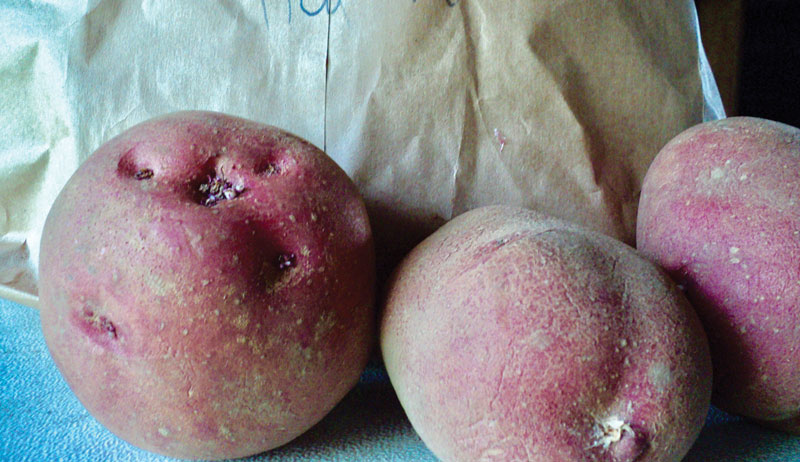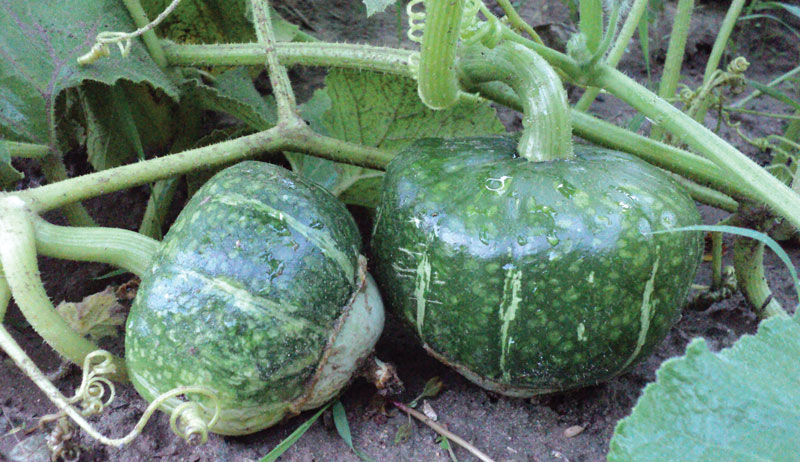
First-rate vegetable storage begins with the soil, as root cellar storability is influenced by growing conditions. Root vegetables grown in soil with an excess of nitrogen will have watery growth and store poorly. Excess watering and watering near harvest time will lead to the same undesirable results.
Conversely, an abundance of organic matter (and particularly the presence of potassium and calcium in the soil) enhances storability. Potassium sources include seaweed, wood ashes and greensand, as well as most green manures, compost and animal manures (especially pig, horse and sheep).
Calcium is abundant in limestone, bone meal and wood ashes.
Post-Harvest Pointers
While the general post-harvest rule is to cool produce as quickly after harvest as possible and keep it cool (to keep produce respiration and therefore deterioration at a minimum), there are exceptions with some long-term storage produce.
Curing, or drying, needs to be performed with garlic, onions and shallots by allowing the entire plant to dry before removing the stems and roots. Harvested potatoes should be kept at 55 to 60 degrees Fahrenheit for several weeks before they are placed in storage conditions.
For sweet potatoes, pumpkins and winter squash, curing allows excess moisture to evaporate and sets/hardens the skin as well. It requires keeping them for 10 to 14 days at 80 to 85 percent relative humidity and 80 to 85 degrees F in a well-ventilated location where they won’t get wet.
Note: Curing is detrimental to, and shouldn’t be done with, acorn-type winter squash.
There are others steps that will favorably influence produce storage. Of course, the most sound, unblemished, disease-free specimens should be kept. And all produce intended for storage should be handled delicately to avoid bruising or damage.
Cabbages should retain their stems, being cut directly above their roots rather than below their head. Potatoes shouldn’t be wetted but rather rubbed to remove excess dirt. Root vegetables should be left as long as possible in cool, though not freezing, soil conditions as this will stimulate the production/storage of sugars and starches in the roots and allow your intended storage areas to achieve cool, even temperatures prior to moving in your produce.
Also, harvested root vegetables should have their greens removed quickly to prevent moisture loss. They should be dug from dry rather than wet ground when possible, and gently cleaned. And remember that while a frost or two will sweeten the flesh of winter squash, it also results in a much shorter storage life.
Perfect Places
Long-term food storage has long taken place in extra closets, backrooms, spare cupboards, basements, porches, garages and the like. People will even use holes or simple structures in the ground as a means of storage.
For a location to be a suitable root cellar, a few conditions must be met. Though ideal storage conditions are not identical for all produce, generally the location must be dark and well ventilated.
The optimum temperature for a root cellar (on average) is right around 50 degrees; too warm or too cool (even short of freezing) are both problems. There is definite variation with ideal storage humidity. While garlic, onions, dry beans, pumpkins and winter squash require less humid conditions, produce such as cabbage and any root does better with levels around 90 percent.
Principal Players
Raising suitable varieties is very important with long-term produce storage. Sometimes a variety may be the very best from a field of many that all store well. Sometimes it’s a unique variety that truly stands out from others.
Examples of both are listed in this article.
Here are the absolute musts for winter storage. Mostly staples and a couple of surprises, these are the variety-specific crops to grow.
Alliums
If you like alliums, your storage cup will runneth over! Garlic has many stiff-neck varieties with a respectable storage of many months. German Extra Hardy and Chesnok Red are two favorites.
However, many soft-necks (with the flexible, braidable stems) are known for exceptionally long storage, with Italian Late and Inchelium Red being very popular varieties.
For onions, Red Bull is a particularly good red onion for storage. Yellow storage onions and shallots boast wonderful storage in general, so you can take your variety pick. On the other hand, the “storage leek” is much rarer, with Bandit and Musselburgh being the correct choices.
Read more: Plan now to use winter ice to cool your root cellar in summer.
Cabbage
If red cabbage is your pleasure, Ruby Perfection is excellent for storage. If green is your preference, Dottenfelder Storage, European Storage and Langedijker Winterkeeper are exceptional varieties.

However, when it comes to impressive storage (at times reaching months), you should consider savoy cabbage.
More nutritious than a regular green cabbage, savoys are perfect additions to winter soups and casseroles. Though they’re more toothsome than green cabbage, they’re also excellent for raw consumption. Go with Winterfurst.
Carrots
Believe it or not, some carrot varieties don’t have the aptitude for long-term storage. A number of varieties with blunter shapes maintain their quality well, including Bolero, Rodelika and Scarlet Nantes Improved.
Still, the capstone of storage carrots is Rolanka. Its carrots are deep orange and maintain their sweetness for many months. Long in length and large in diameter, attentive culturing can even induce individual carrots to reach 1 pound in size—a serious storage carrot!
Dry Beans
Dry beans can be overlooked as a storage crop for the garden—perhaps because economical, convenient options are readily available elsewhere. But what about the exceptional?
The world of dry beans offers many wonderful heirloom options, including Aunt Ada’s Italian (blocky shape, tan color), Drabo (white) and Jacob’s Cattle (highly attractive, white/reddish-brown mottling).
At the top of the list, however, sits Black Valentine.
Having a hardy and vigorous plant, it grows well under adverse conditions. A top source of phytonutrients (as many darkly colored dry beans are), it also holds its shape well in soups.
Note that when considering growing other dry beans, many can be picked at the green bean stage (as all of these can). Companies will list both “days to picking” in reference to their fresh-picking stage and “days to maturity” for dry-bean shelling—so pay attention.
Kohlrabi
Kohlrabi has become widely known, but you may not be familiar with the storage varieties. While regular kohlrabi must be harvested before they reach 4 inches in diameter, storage varieties achieve much larger sizes.
They can easily be used to make coleslaw, a gratin or even “mashed faux-tatoes.” Keeping for several months easily, kohlrabi will do best packed in moist sand or sawdust (though any humid location will do). Superschmelz (being 8 to 10 pounds) and the purple-skinned and not as huge Blaril (averaging 2 pounds) are the ones to try.
Melons
The Christmas or Santa Claus melon won’t see you through the winter, but it doesn’t need to! With a mild, very sweet flavor and creamy white flesh with a honeydew texture, it earns its keep handsomely.
This melon has a mottled, yellow-green skin, is the size and shape of a football and can achieve 9 pounds in weight. Harvested as late in the season as possible and stored in a cool location (such as a refrigerator), its exceptional storability (approximately 6 weeks longer than an average melon) may keep it around to when the snow starts flying!
Read more: Stable root cellar conditions treat your stored veggies right.
Potatoes
One of the most basic of storage vegetables. Potato varieties have early-, mid- and late-season harvest times, with the “lates” being most prone to good storability. Yukon Gold, Russet Burbank and especially Elba are excellent.
But Red Maria goes above and beyond.

A red-skinned, all-purpose potato with white flesh, Red Maria is unchanged after 5 months in storage when other potatoes are on to wrinkling and sprouting. If Red Maria does sprout, they’re very short, stocky and easily removed.
Begin checking for sprouts in late winter. Toss them into the compost bin, avoiding feeding to animals.
Root Brassicas
Root vegetables were made for long-term storage in the root cellar, of course. Though they may all store fairly well, some standouts emerge.
For example, there are many superb storage radishes, but the watermelons/red meats offer a very attractive appearance. Try Starburst and Beauty Heart.
Zuercher is a fine and versatile turnip. It may be harvested at salad turnip size as well as allowed to reach that for storage.
Tomatoes
Everyone tries to extend the “tomato time” of the year for as long as possible, gathering unripened fruits at the end of the season and following specialized procedures to ensure the greatest possible longevity.
Garden Peach is a very sweet, yellow tomato with a tender skin and is a good keeper, holding easily for a month or two. But if you want tomatoes in April of the following spring, Longkeeper (red) and Golden Treasure (rich yellow) are the tomatoes for you.
Golden Treasure’s distinctly acidic tang and firm skin equips it perfectly for its truly remarkable storage.
Winter Squash
Winter squashes aren’t all created equal when it comes to storage. Acorn is least storable, at only a couple of months.
Hubbard, banana and buttercup will easily store twice as long, actually improving in flavor with storage (try Blue, Sibley and Bonbon, respectively). So, too, will butternuts.

For top-level storage (not to mention superior nutrition), it’s difficult to beat the Waltham. Averaging 4 pounds, possessing an edible skin and widely considered the benchmark of butternuts, it’s an old favorite for a very good reason.
Make room for the production and storage of these crops on your farm. You’ll be glad you did!
More Information
Dry Ideas
Dehydration is a handy method for keeping food. It’s most popularly done with blueberries, celery, greens (especially kale), hot peppers, mushrooms, snap beans, sweet corn, tomatoes, almost all herbs and apples!
For apple dehydration, your preferences are all-important. If you want an apple that holds its shape very well (for attractive apple rings), try Golden Delicious or Pink Lady.
If you want a very sweet dehydrated apple, choose from Cortland, Fuji and Gala. Looking for a tart taste? Braeburn and Granny Smith are the apples for you.
Cold Comforts
Freezing is a great way to preserve several foods that can’t be kept with (long-term) fresh storage in the root cellar. It may require produce to be blanched (submerged in boiling water for a short period, then immediately chilled in cold water) or not, depending on the food.
For Freezing
Blanch
- broccoli
- cauliflower
- celery
- greens
- shelling peas
- snap beans
- sweet corn
Do not blanch
- bell peppers
- berries
- melon
- peaches
- tomatoes
Root Cellar Runners-up
If you have plenty of room to dedicate to winter food (and even some to experiment in), try some of these keepers:
Beet
For serious winter storage, Lutz Green Leaf, aka Winterkeeper, is the one to try.
Cape Gooseberry
Similar to the husk or ground cherry, the cape gooseberry (Physalis peruviana) is a larger fruit with an almost tropical fruit flavor and the same in-the-husk storability.
Celery
Celery for storage? Try placing plants in 5-gallon pails for continued production. Choose between Fordhook and Giant Pascal.
Mushroom
Darkened conditions (completed with a humidity tent) are perfect for growing a mushroom kit!
Popcorn
Add Vermont Red Kernel to your corn patch and pop away.
Pumpkin
For exceptional flavor and fair storage, try Winter Luxury. For good flavor and exceptional storage, Long Pie.
Sweet Potato
Stores in warmer conditions than the typical root cellar. Try Allgold.
This article originally appeared in the September/October 2022 issue of Hobby Farms magazine.




